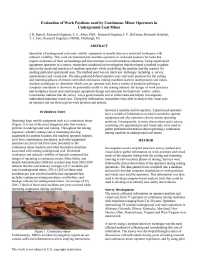Mining Publication: Evaluation of Work Positions used by Continuous Miner Operators in Underground Coal Mines
Original creation date: October 2009
Operation of underground coal mine mobile equipment is usually done in a restricted workspace with reduced visibility. This work environment puts machine operators in awkward postures for tasks that require awareness of their surroundings and fast reactions to avoid hazardous situations. Using experienced equipment operators as a source, researchers conducted an investigation that developed a method to gather data on the needs and practices of machine operators while controlling the machine and the reasons for needing particular operational cues. The method used was an interview technique including a survey questionnaire and visual aids. The data gathered defined operator cues and work positions for the cutting and tramming phases of remote controlled continuous mining machines used in underground coal mines. Analysis techniques to determine which cues an operator sees from a variety of positions utilizing a computer simulation is shown to be potentially useful to the mining industry for design of work practices and workplace layout and could impact equipment design and selection for improved worker safety. Conclusions indicate that the survey was a good research tool to collect data and helped investigators understand important visual cues. Using this information, researchers were able to analyze the visual cues an operator can see from a given work position and posture.
Authors: JR Bartels, CC Jobes, JP DuCarme, TJ Lutz
Conference Paper - October 2009
NIOSHTIC2 Number: 20036014
Proc Hum Fact Erg Soc 53rd Ann Meeting, October 19-23, 2009, San Antonio, Texas. Santa Monica, CA: Human Factors and Ergonomics Society, 2009 Oct; 53:1622-1626
See Also
- Analyzing Factors Influencing Struck-By Accidents of a Moving Mining Machine by Using Motion Capture and DHM Simulations
- Characteristics of Gait in Restricted Vertical Space Versus Unrestricted Walking
- Effects of Lifting in Four Restricted Postures
- An Ergonomic Evaluation of Excavating Operations: A Pilot Study
- NIOSH Hazard ID 1 - Exposure to Silica Dust on Continuous Mining Operations Using Flooded-Bed Scrubbers
- Programmable Electronic Mining Systems: Best Practice Recommendations (In Nine Parts): Part 2: 2.1 System Safety
- Programmable Electronic Mining Systems: Best Practice Recommendations (In Nine Parts): Part 8: 6.0 Safety File Guidance
- Technology News 539 - Identifying The Benefits Of Engineering Noise Controls Through A Business Case
- Underground Test Results of a Laser-Based Tram Control System for a Continuous Miner
- Using Coal Miners' Experience To Identify Effective Operating Cues
- Page last reviewed: 4/1/2015
- Page last updated: 4/1/2015
- Content source: National Institute for Occupational Safety and Health, Mining Program


 ShareCompartir
ShareCompartir
